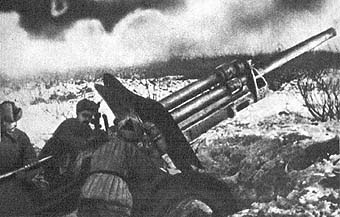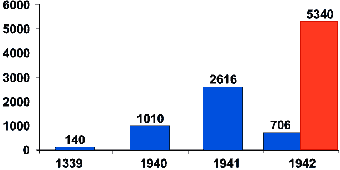 
* similar to the ZIS-3
PRODUCTION OF THE F-22 USV Blue - output of the Factory #92; |
||||||||||||||||||||||||||||||||||||||||||||||||||||||||||||||||||||||||||||||||||||||||||||||||||||||||||||||
In March 1937, the GAU issued new Tactic-Technical Characteristics (TTCh) for divisional guns:
- elevation +45°
- weight 1,500 kg
- transportation speed 30 km/h
- 680 m/s muzzle velocity of the 6.23-kg round (the same ballistics of the 40-clb 76 mm Gun Model 1902/30).
The design bureau of the Kirov Factory was ordered to develop a new divisional gun using these TTCh's. Soon, they developed a new gun, named the L-12. That gun used some ideas from the L-3, L-4 and L-10 guns (including the recoil brake mounted together with the gun-cradle). Later, that idea was used for the L-11 and L-15 tank guns. The L-12 had a semi-automatic wedged breech-block, the elevation mechanism had two sectors, the optic sight was the AL-18, and the gun's wheels were taken from the ZIS-5 truck.
The factory trials took place from February 7 to April 7, 1938. Three guns were successfully tested. Then, in May 1938, four L-12 guns were tested on the NIAP's proving ground. According to the conclusion of the special commission, the L-12 failed trials because of the weak construction and poor performance of the recoil brake. The commission ordered to improve all these defects. After it was modified, in August 13-14, 1938, four L-12 guns were tested again, and the trials were successful.
In April 1938, because trials of the L-12 failed, Kondakov's Design Bureau was ordered to develop a new divisional gun. New 76 mm gun was ready in several days and was named the "76.2 mm NDP Divisional Gun Model 1938." In some recent articles this gun is named the NDP-76, but this author has never seen that designation in archival documents, so this may be an error made by modern writers. The NDP had a massive gun-cradle in which the recoil brake was mounted. Over the barrel there was a hydraulic compressor, and under the barrel there was a reflexive spring. The gun had a semi-automatic breech-block, and the gun's wheels were taken from the ZIS-5 truck.
The experimental prototype of the NDP was manufactured in the Arsenal Factory #7 and in April 29, 1938, it was sent to NIAP's proving ground. The NDP had failed its tests due to a defective recoil brake and semi-automatic breech-block.
According to Grabin's memoirs, he was informed of the new TTCh and the latest L-12 in April 1938 - after 13 months had passed. He started on his own gun immediately. However, for unknown reasons, he decided to modernise his previous F-22 instead of developing a completely new gun. The modernised F-22 was named F-22 USV, where "USV" stands for "usovershenstvovannaya" (modernised and improved). In fact, it was almost a completely new gun; it's barrel was shortened by 10 calibers, and it's ballistics became similar to the 76 mm Gun Model 1902/30.
The USV had a semi-automatic wedged breech-block, and both the recoil brake and reflexive mechanism were hydraulic. The gun-cradle was of the Bofors type, the elevation mechanism had one sector, and the gun's wheels were taken from the ZIS-5 truck. The maximum elevation of the barrel was +45°, but the very first prototype had an elevation of +75°. The USV had a limber either from the 76 mm Gun Model 1936, or a "unified limber" for regimental and divisional guns that was developed in 1942.
Factory #92 produced four experimental guns. Factory trials took place from August 1938 until March 1939. On March 28, 1939, the guns passed new trials on NIOP's proving grounds. Those trials revealed some major defects of the USV: weak construction of the gun carriage and gun-cradle (they cracked during firing) and an oil leak in the hydraulic recoil brake.
From June 5 to July 3, 1939 on Luzhsiy proving ground, two batteries of four USV and L-12 guns each passed comparative trials. The battery of USV guns fired 4,099 rounds and ran 1,142 km. The battery of L-12's fired 4,015 rounds and ran 1,182 km. All guns successfully passed the trials. The commission chose the USV because it had better performance and field exploitation characteristics. According to order JAK #0016, on July 5, 1939, the plenary session of the AK (Artillery Commission) confirmed that choice. To start the mass production of the F-22 USV, the plenary session ordered:
"1. In Factory #92, the USV must be improved, and all necessary documentation must be issued no later than August 15, 1939.
2. Factory #92 must manufacture the first 200 guns no later than January 1, 1940."
It is important to note that before the Great Patriotic War, production of USV and other 76 mm divisional guns ceased because the Russians were to convert to larger calibers such as 85 mm, 95 mm and 100 mm. By June 22, 1941, 1,170 USVs served in the Red Army. After the beginning of the Great Patriotic War, production of the USV was resumed. The Red Army received 100 USV's in September 1941, 250 USV's in October, 400 USV's in November, and 800 USV's in December. From 1942, production of the USV was set up in the Barrikady factory as well. Barrikady guns had some minor differences, and were named the "F-22 USV-BR." You can distinguish the USV from the USV-BR by their shock absorbers: the USV had lamellar springs while the USV-BR had four cylindrical shock absorbers. The transportation weight of the USV-BR was 2,070 kg, and its combat weight was 1,560 kg.
In the beginning of 1942, Grabin's design bureau had modernised their USV and renamed it the ZIS-22-USV. The modernised variant was distinguished from its base model by:
- the free-floating barrel;
- the jacket and screwing breech was replaced by a unified barrel with breech joined by a muff;
- the construction of the semi-automatic breech-block was improved;
- the traversing mechanism was improved;
- the lamellar springs had been replaced by cylindrical shock absorbers;
- the riveted gun carriage was replaced with a welded one (assembled from three pieces);
- the gun was equipped with the new ZIS-13 sight.
Serving from 1940 in regular infantry rifle divisions and antitank regiments (IPTAPs), these guns were the prevalent Soviet divisional guns and antitank weapons in the initial period of the Great Patriotic War.
At the beginning of the war, the Germans captured several hundreds of these guns. Gun's breech-blocks were re-bored to accept german ammo, and a muzzle brake was fitted on the barrel. The Germans used these guns for their early antitank weapons ("Marder" series).